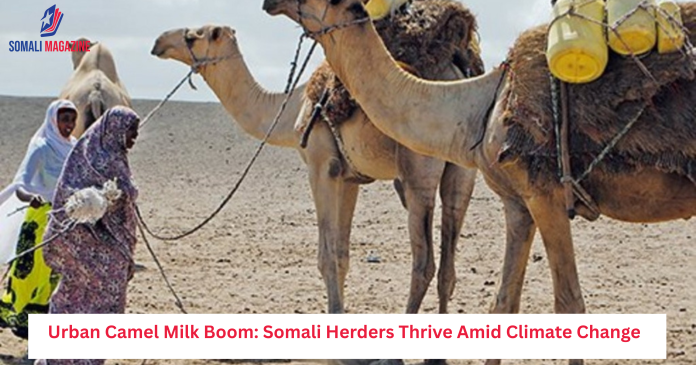Facebook Twitter (X) Instagram Somali Magazine - People's Magazine
Pastoralists in Galgadud region find new hope by relocating camels to towns, earning steady incomes and rebuilding their lives after years of drought
After struggling through three years of harsh drought, Dahir Abdullahi Ali finally found a way to support his family of nine. He brought his 30 camels from the countryside to the outskirts of Adado town in central Somalia’s Galgadud region. There, he began selling camel milk, which has become a reliable source of income.
Dahir is one of many pastoralists in the region who have left behind traditional rural grazing. Due to severe climate changes, it’s become harder to find food and water for livestock in remote areas. Instead, herders are now settling near towns, where they can buy animal feed and sell milk more easily.
Dahir, who is 40 years old, milks his camels twice every day. Each morning, he collects around 46 liters of milk. After covering the cost of feed and water, he earns at least $20 daily. This money is enough to feed his family three meals a day and cover other basic needs.
“This money has helped us escape the poverty we’ve endured for so long,” he told Radio Ergo.
Before he moved his camels to the town in February, life was extremely hard. His family could only afford one meal a day and struggled to pay their bills. Now, thanks to the milk sales, things have turned around.
When Dahir first arrived from the rural village of Do’oley, his camels were weak and not producing milk. But after feeding them with fodder he bought on credit, the camels regained their health and began producing milk again. That’s when he started earning money.
“I’ve spent my whole life raising livestock,” Dahir said. “But this is the most profitable time I’ve ever had. This method is better for both the animals and us.”
Even though the rains have started, Dahir doesn’t plan to return to the countryside. He believes the camels may not adjust well again, and he prefers the steady income he now receives. His goal is to grow his herd to 70 camels and continue raising them in the town.
He’s already used part of his earnings to repay $650 of a $1,000 debt and has enrolled six of his children in school, paying $60 a month in fees. His family also owns 60 goats that are now recovering from the drought, as he can afford to feed them regularly. Unlike before, he no longer needs to roam the bush for days chasing after his animals.
“This new way gives me hope for my animals’ future,” Dahir said. “I was desperate before.”
Other herders like Kafi Abdullahi Adan have also found success with this urban camel-keeping approach. Kafi brought 50 camels into Adado earlier this year. Now, he sells about 27 liters of milk daily from 15 of them and says his life has greatly improved.
“Life has improved a lot. We went through very difficult times, but now things are much better,” Kafi said.
Kafi used to work as a laborer at construction sites for $10 a day when work was available. Today, he no longer relies on credit to buy feed, and he has started repaying a $1,500 debt. He said the idea came when he realized how much people in the town needed camel milk.
With the rainy season here, he hopes nearby pastures will grow again, which would reduce his costs and increase profits.
According to Abdinur Hassan Osman, an economics lecturer at Galmudug University, this shift to keeping livestock in towns could significantly boost the local economy. It helps herders survive climate hardships and provides steady income.
Even women and non-herders are benefiting—those selling milk in markets now make up to $5 a day, something they couldn’t do when camels were only kept in remote areas.
“Pastoralists must adapt to climate change,” said Abdinur. “Urban camel farming is proving to be one of the most reliable and profitable ways to earn a living from livestock.

